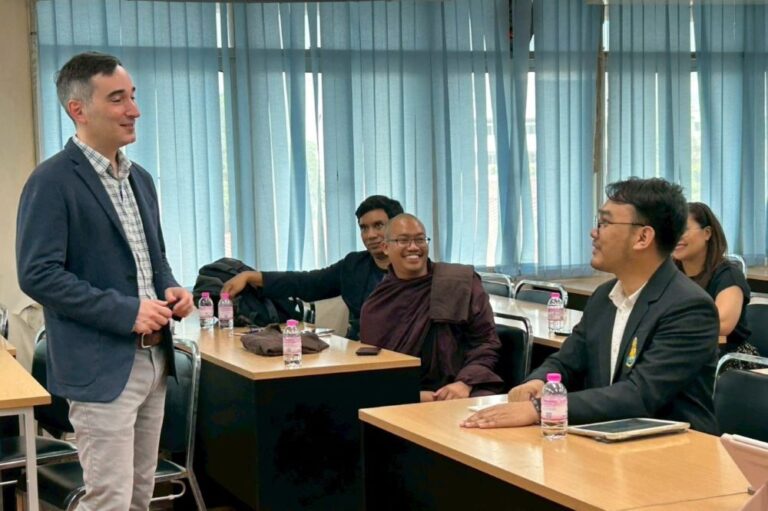

The MSU Department of Art, Art History, and Design (AAHD) has rolled out a new Graphic Design undergraduate major this Spring 2016. To date, 42 students have enrolled in the new BFA program since December 2015.
“The department’s goal with the new major is to provide an opportunity for more intensive upper-level development in the graphic design discipline, as well as a more clearly established link to the profession and its career opportunities.” says Chris Corneal, AAHD chair and associate professor of graphic design.
“Our curriculum is a sequence of learning objectives that addresses all the current needs for a professional degree in graphic design,” Corneal says.
“Beginning with enduring design foundations, coursework progresses toward complexity in the upper-level classes. Form, typography, packaging, motion, interactive web, environmental systems, and identity systems are all included.”
“This new major provides students with the advanced technical knowledge, artistic control, and professional expertise to create meaningful communicative designs reflective of their individual artistic styles, their beliefs, and their world view.”
Christopher P. Long
Says College of Arts & Letters Dean Christopher P. Long, “Graphic design informs so many aspects of our lives that it is critical to give students a broad appreciation of its basic principles and a deep understanding of its capacity to shape relationships and convey meaning. This new major provides students with the advanced technical knowledge, artistic control, and professional expertise to create meaningful communicative designs reflective of their individual artistic styles, their beliefs, and their world view.”
Students Laud New Major
Junior Lindsay Poll says, “I’m very excited about it. As someone who wants to be a graphic designer, I feel the advantages of the major are that you’re more specialized, you’re learning more about graphic design, working more on it, and doing more of what you will be doing after you graduate.”
Professional Writing major and senior Will Mianecki, who is in process of adding a second major in graphic design adds, “I think, as an aspiring graphic design professional, it’s important that I come out of school with a BFA in graphic design, because today’s employers expect it.”

A major strength of AAHD’s graphic design program is its dedicated faculty including Corneal, Co-Coordinators of the Graphic Design program Associate Professor Kelly Salchow MacArthur and Assistant Professor Rebecca Tegtmeyer, as well as two recently hired tenure-system faculty, Assistant Professors Zach Kaiser and Ben Van Dyke, who are helping the program ramp up its interactive and new media design areas.
All five stress that the addition of the major is both in response to continuing gains in prominence and respect for the role of design in business, as well as a move to affirm the rigor and professionalism of MSU’s graphic design curriculum.
“Today’s graduates are expected to have a working knowledge of both print and interactive design, as well as have professional experience before they graduate,” says Salchow MacArthur. (In fact, a design internship has been part of the MSU graphic design curriculum for many years.) “Our graduates are increasingly being called upon to work on multiple simultaneous projects, and lead teams having wide-ranging roles in the execution of large design strategies.”
“Our program strives to challenge students to think about and practice design from all levels, from components of form to systems of community.”
Rebecca Tegtmeyer
Tegtmeyer agrees, saying, “Our program strives to challenge students to think about and practice design from all levels, from components of form to systems of community. It establishes a workable skill set that positions graduates to enter the profession with visual and verbal acuity, agile problem-solving skills, design thinking strategies, practice in concept innovation, collaborative abilities, critical research methods, and maturity in both analog and digital production.”
Job Market Needs for Graphic Designers
The program co-coordinators agree that graphic design graduates have many career opportunities and design areas they can pursue including identity systems; wayfinding and environmental signage; exhibitions; website design; software, mobile and user interfaces; film and broadcast television graphics and titles; typeface design; packaging; poster design; corporate brand development; retail design; and more.
“Graduates of the program generally enter the field as entry-level graphic designers, and move up the ladder at a reasonable pace to become creative directors and art directors,” Salchow MacArthur says. “Positions exist in large and small design firms, advertising, marketing and public relations agencies, production companies, publishing companies, and in-house corporate and organizational design offices.
Adds Tegtmeyer, “The skill sets and design areas mentioned earlier are becoming more and more important to businesses, corporations, and organizations because designers are increasingly paving the way in creative innovation. We are leaders in facilitating change in meaningful ways, and as a result, businesses value and hire graphic designers, a fact borne out by recent job figures and expanding industry roles and titles.”
In support of this statement, the U.S. Bureau of Labor Statistics notes that in 2014, there were 261,600 graphic designers. And the American Institute of Graphic Arts (AIGA) currently lists three new, emerging industry job titles on its design careers web page:
- Design Executive Officer
- Creative Technologist
- Content Strategist
The college’s graphic design alumni often work at major agencies such as Leo Burnett, MRM/MCann, Campbell Ewald, and top companies such as Quicken Loans, Team Detroit, General Motors, Ford Motor Company, Shift Digital, Domino’s, and TechSmith Corporation. Common job titles include Graphic Designer, Art Director, Creative Director, Web Designer, Marketing Specialist, Mobile Designer, Packaging Designer, and Creative Producer.
Concludes Tegtmeyer, “The Graphic Design major reinforces the importance of visual communication as an area of study and practice. It acknowledges its role in society as a vital force in facilitating change, creating awareness, and influencing progress in how people view information as passive to active participants.”
If you have any questions or interest in the Graphic Design major, contact Rebecca Tegtmeyer or Kelly Salchow Macarthur.


